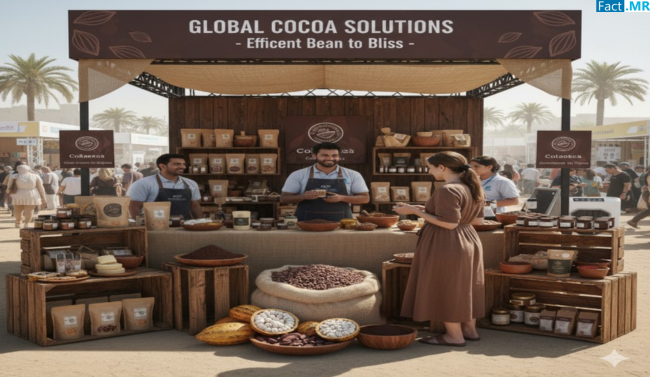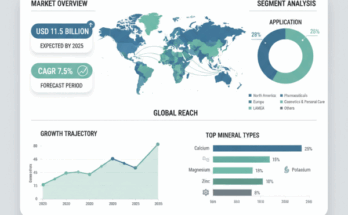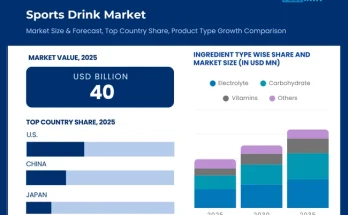The global cocoa market is witnessing a transformative phase as demand for chocolate, confectionery, and functional food products continues to rise. With growing consumer awareness about health, sustainability, and ethical sourcing, cocoa has emerged as a critical ingredient not just for indulgence but also for wellness-oriented applications. The market is evolving rapidly, driven by innovations in processing, product development, and supply chain transparency.
Market Overview
Cocoa is a versatile raw material used in chocolates, beverages, bakery products, and increasingly, in nutraceuticals and cosmetics. Its appeal extends beyond flavor, as cocoa is rich in natural antioxidants and flavonoids, making it attractive for health-focused formulations. Manufacturers are increasingly prioritizing high-quality, traceable cocoa to meet consumer demand for clean-label, ethically sourced, and premium products.
The cocoa market encompasses several key segments:
- Product Type: Cocoa powder, cocoa butter, cocoa liquor, and chocolate-based ingredients. Each segment caters to different applications, from food and beverages to cosmetics and functional foods.
- Processing: Cocoa is processed into ingredients that enhance flavor, solubility, and functional properties in end products. Innovations in defatting, alkalization, and grinding allow for greater formulation flexibility.
- Distribution Channel: Cocoa products reach the market through direct manufacturing, distributors, and retail, including specialty and e-commerce channels.
- Application: End-use industries include confectionery, bakery, beverages, dairy, cosmetics, and nutraceuticals.
Drivers of the Cocoa Market
Several factors are propelling the growth of the cocoa market:
Health and Functional Trends
Consumers increasingly prefer products that offer health benefits. Cocoa’s polyphenols and flavonoids are linked to heart health, cognitive function, and anti-inflammatory effects, making cocoa-based products popular in functional foods and beverages. This trend has boosted demand for cocoa powder, extracts, and specialty ingredients in clean-label formulations.
Ethical and Sustainable Sourcing
The demand for ethically produced cocoa has grown significantly. Consumers and regulatory bodies now expect transparency in supply chains, with certifications like Fair Trade, Rainforest Alliance, and organic labeling becoming standard for premium chocolate products. This has incentivized investments in traceable, sustainable cocoa farming.
Premiumization and Artisan Products
Origin-specific, single-origin, and bean-to-bar chocolates are driving a premiumization trend. Countries like Ecuador, Peru, and Ghana are leveraging their heritage cocoa varieties to create high-value products. Artisanal chocolates and boutique confectionery are increasingly popular in developed regions, influencing both supply and demand patterns.
Innovation in Food and Beverages
The cocoa market is experiencing product innovation across beverages, bakery, dairy, and confectionery segments. Cocoa powders with high solubility, controlled pH, and tailored fat content allow manufacturers to create functional, high-quality products. Defatted cocoa powders and specialty extracts are also gaining traction in nutraceuticals and protein formulations.
Regional Insights
Cocoa production and consumption patterns vary globally, shaping market dynamics:
Africa
West Africa remains the largest cocoa-producing region, with Côte d’Ivoire and Ghana leading global supply. Both countries are implementing sustainability programs, including digital traceability, cooperative farming models, and agroforestry initiatives, to enhance yield consistency and meet international standards.
Asia-Pacific
Emerging markets like Indonesia, India, and the Philippines are increasing cocoa processing and grinding capacity to meet growing domestic and regional demand. Rising disposable incomes, investment in sustainable agriculture, and interest in functional foods are driving market expansion.
Europe
Europe is a leading importer of cocoa and a hub for premium and ethical chocolate. Countries like Switzerland, Belgium, and Germany are spearheading the use of organic and bean-to-bar products. Strict procurement policies and deforestation regulations are pushing manufacturers to ensure traceability and sustainability.
North America
The U.S. and Canada are witnessing steady demand for ethically sourced and clean-label chocolate products. Collaboration with certified suppliers, flavor innovation labs, and traceability platforms is strengthening the market’s focus on quality and transparency.
Latin America and Middle East & Africa
Countries such as Ecuador and Peru are driving premiumization through origin-specific differentiation. In the Middle East, rising consumer interest in high-quality chocolates and government support for crop diversification are fostering market growth.
Challenges and Restraining Factors
Despite growth opportunities, the cocoa market faces several challenges:
- Bean Quality Variability: Cocoa quality is highly dependent on agro-climatic conditions, soil health, and post-harvest practices. Variability in flavor profiles and bean consistency can impact processing and end-product quality.
- Limited Access to Technology: Smallholder farmers often lack access to modern fermentation equipment, pest control methods, and agronomic training, limiting yield and quality.
- Infrastructure Constraints: Poor warehousing, cold storage, and logistics in producing countries lead to post-harvest losses and inefficiencies in supply chains.
- Sustainability Compliance: Meeting global sustainability and deforestation standards requires significant investment in traceability, certifications, and environmental practices.
Country-Specific Insights
Côte d’Ivoire
Côte d’Ivoire is strengthening its cocoa systems through digital traceability, cooperative farming, and agroforestry practices. Investments in drying equipment, mobile payments, and standardized post-harvest processing are improving quality consistency and compliance with international sustainability regulations.
Ghana
Ghana’s COCOBOD system ensures consistent quality, ethical sourcing, and premium pricing for farmers. Government initiatives in extension services, mass spraying programs, and blockchain-based farm tagging are enhancing traceability, child labor remediation, and reforestation efforts.
Indonesia
Indonesia is expanding its cocoa processing capabilities, particularly in Sulawesi and Sumatra. Investments in grinding, dry-mixing, and farmer training programs are increasing bean quality and export competitiveness. Sustainability initiatives, including agroforestry and pest control, are being implemented to meet international standards.
Category-Wise Analysis
Cocoa Powder
Cocoa powder is gaining popularity due to its functional properties, solubility, and clean-label appeal. It is used extensively in bakery, dairy, beverages, and functional food products. Defatted and alkalized powders allow manufacturers to control fat content and flavor intensity for various applications.
Cocoa Butter and Cocoa Liquor
Cocoa butter and liquor remain essential ingredients for chocolate production and cosmetics. Innovations in extraction and processing are enhancing quality, shelf life, and application versatility. Premium, ethically sourced variants are driving consumer demand in high-end and artisanal markets.
Strategic Implications and Opportunities
To capitalize on cocoa market growth, stakeholders can consider:
- Investing in Sustainable Farming: Supporting smallholder farmers with training, technology access, and cooperative models ensures consistent supply and quality.
- Focusing on Premiumization: Single-origin, bean-to-bar, and functional cocoa products cater to evolving consumer preferences for quality and traceability.
- Expanding Processing Capabilities: Investments in local grinding, extraction, and packaging facilities can reduce costs and improve market responsiveness.
- Leveraging Digital Traceability: Blockchain, IoT, and farm-mapping tools enhance transparency, sustainability compliance, and consumer trust.
Conclusion
The cocoa market is poised for sustained growth, driven by health-conscious consumption, ethical sourcing, and premiumization trends. Regional investments in processing infrastructure, sustainable farming, and traceability are shaping the future of cocoa supply chains. As consumer demand for high-quality, functional, and ethically produced cocoa products continues to rise, stakeholders who embrace innovation, sustainability, and quality-focused strategies are likely to lead the market in the coming decade.



